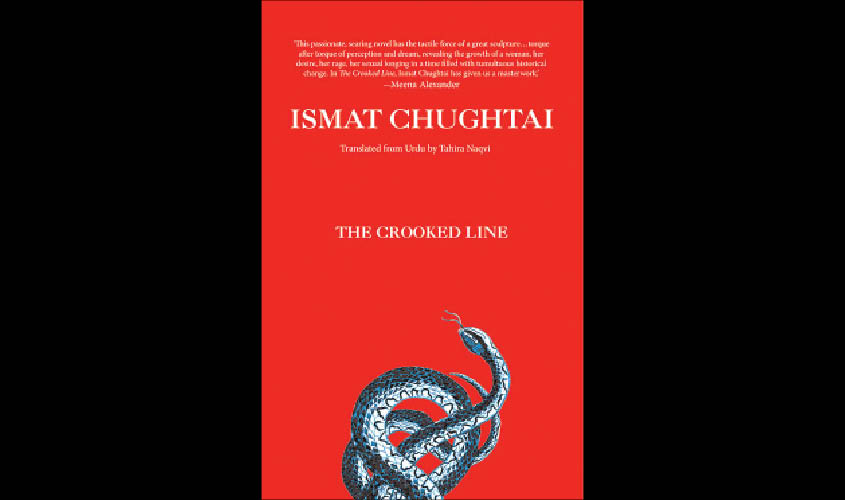Originally published in Urdu in the ’40s, Ismat Chughtai’s Terhi Lakir prefigured the works of Simone de Beauvoir and other feminists, writes Tahira Naqvi, who has translated the novel into English.
In The Crooked Line (Terhi Lakir), Ismat Chughtai, one of Urdu’s boldest and most outspoken writers, cuts to the core of the female psyche, exposing it layer by layer in her searing, candid style as no other writer of the Indian subcontinent, male or female, has done before or since. She leaves out very little. Relationships of women with each other within the sphere of the extended family, the dynamics of a nascent female identity as it reveals itself in relationships between young girls grappling with sexual urges in an environment dominated by a female presence, relationships between women and men, the connection between women and their social and political milieu—there is hardly any aspect of female experience that Chughtai does not draw upon in The Crooked Line. The narrative, drawing heavily on Ismat Chughtai’s own experiences, as does most of her other fiction, revolves around the experiences of Shaman, beginning with her birth as the tenth and youngest child in a middle-class Muslim family where traditional mores and cultural constraints maintain an oppressive hold on the lives and behaviour of all its members. But the narrative functions only as a vehicle whereby Ismat Chughtai exposes the social cultural conflicts and the psychosexual determinants that govern the development of female consciousness.
It is important to note that the subject of women’s lives had often been taken up by Indian writers before Ismat Chughtai appeared on the scene. An example is Mirza Ruswa’s Umrao Jan Ada, a classical Urdu work of the late 1800s in which the narrator/protagonist is a beautiful courtesan who is also a gifted poet with a mind of her own. One of Urdu’s earliest novels, Nashtar (The Surgical Knife), written by Hasan Shah in 1790, centres on the life of Khanum Jan, a dancing girl who also appears to be well-versed in the traditions of classical literature. Another massive, three-part novel, Goodar Ka Lal (A Jewel Among Rags), written in the 1920s by a woman who merely called herself Walida Afzal Ali (Mother of Afzal Ali), focuses on the value of education for women by drawing parallels between the lives of Mukhtar Dulhan who has little education and is doomed to failure
In the early chapters of The Crooked Line we see how women, unempowered in a man’s world and unable to govern their own destinies, develop a flawed and second-class mode of empowerment within the confines of their limitations and begin to oppress other women; we see clearly how some women, quite unselfconsciously, often naïvely, participate in the perpetuation of the tradition of oppression, how they can cruelly cut down another female just as society cruelly cuts them down. One example is Shaman’s oldest sister Bari Apa, who, widowed a few years after her marriage and having returned to her parents’ house with two young children, has relinquished the joys of living and in keeping with the demands of convention, “had annihilated her femininity for the sake of her father’s honour”, even though she is still young. Frustrated sexually and emotionally, lacking proper status in society, weakened in her traditional role as wife and mother, she now seeks a scapegoat and finds it in the person of her youngest sister Shaman who, unlike her, seems to have no regard for any kind of convention.
Taking us through some of the most brilliantly written pieces about childhood fixations and fantasies, Chughtai focuses on Shaman’s emotional deprivation in a house filled with siblings, nannies, servants and a mother and father. These feelings, induced by her mother’s aloofness and later heightened by her traumatic separation first from her wet-nurse Unna and then her older sister Manjhu, and the rejection she experiences at the hands of her oldest sister Bari Apa, convinces her that she is fated to remain unloved. Shaman’s rebellion against all that is considered proper and “nice” further complicates the situation. As a matter of fact, her birth is “ill-timed”; with her early arrival she surprises and disappoints her mother whose “longstanding desire to send for the English midwife came to naught.” And the “howl” with which she makes her appearance puts fear into the hearts of her older sisters and others who happen to be around, and marks the first sign of mutinous behaviour. Bari Apa finds it easy to make Shaman the target of her own discontentment and sense of defeat in the face of unrelenting social standards. She badgers and torments her young sister, attempting at every step to draw comparisons between Shaman’s ineptness and her own daughter Noori’s superiority, continuing with Shaman’s belittlement in mean and nasty ways until Shaman comes to hate her and, totally unsympathetic to Bari Apa’s “stifling of her own desires”, she begins to think of her as a “snake” and “would not have minded at all if Bari Apa decided to sell herself.” Bari Apa in turn has been treated badly by her mother-in-law, who, when her son was living, used every opportunity to make her daughter-in-law as unhappy as she could, her efforts largely aimed at keeping her out of her son’s bedroom. And so the cycle of oppression feeds on itself among all the females in this household.
Excerpted with permission from ‘A Crooked Line’, written by Ismat Chugtai, translated by Tahira Naqvi, and published by Speaking Tiger Books in association with Women
Unlimited

